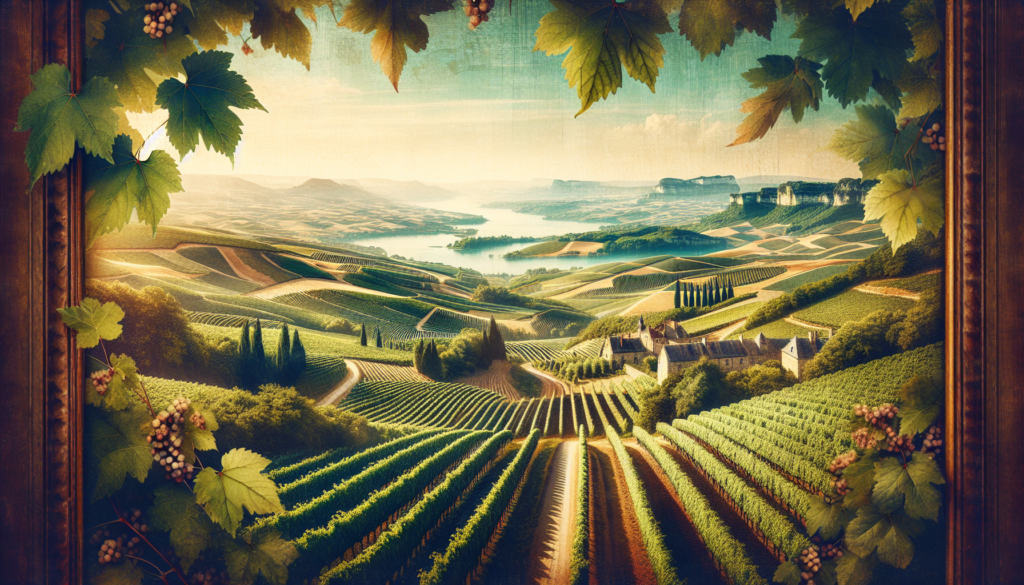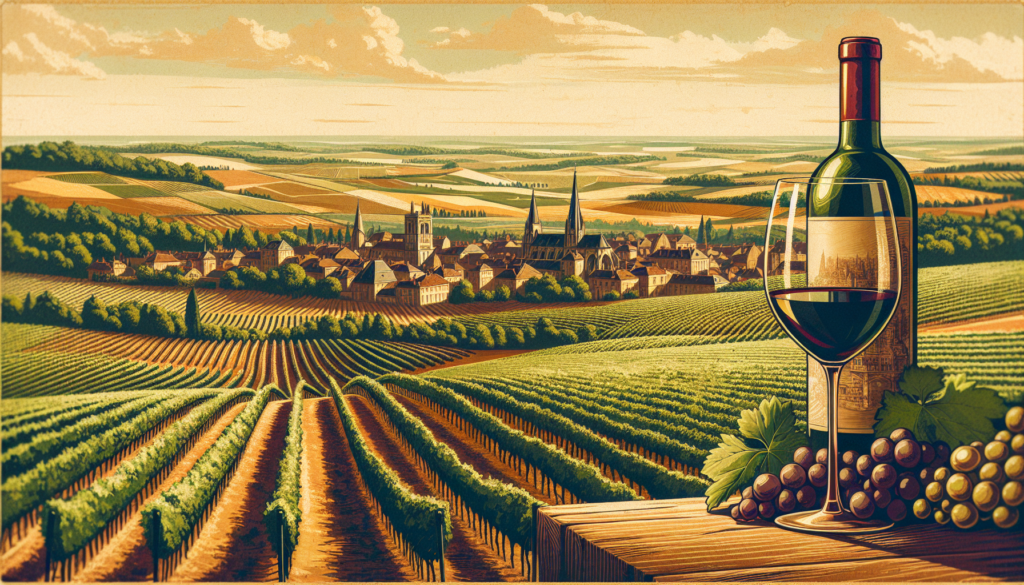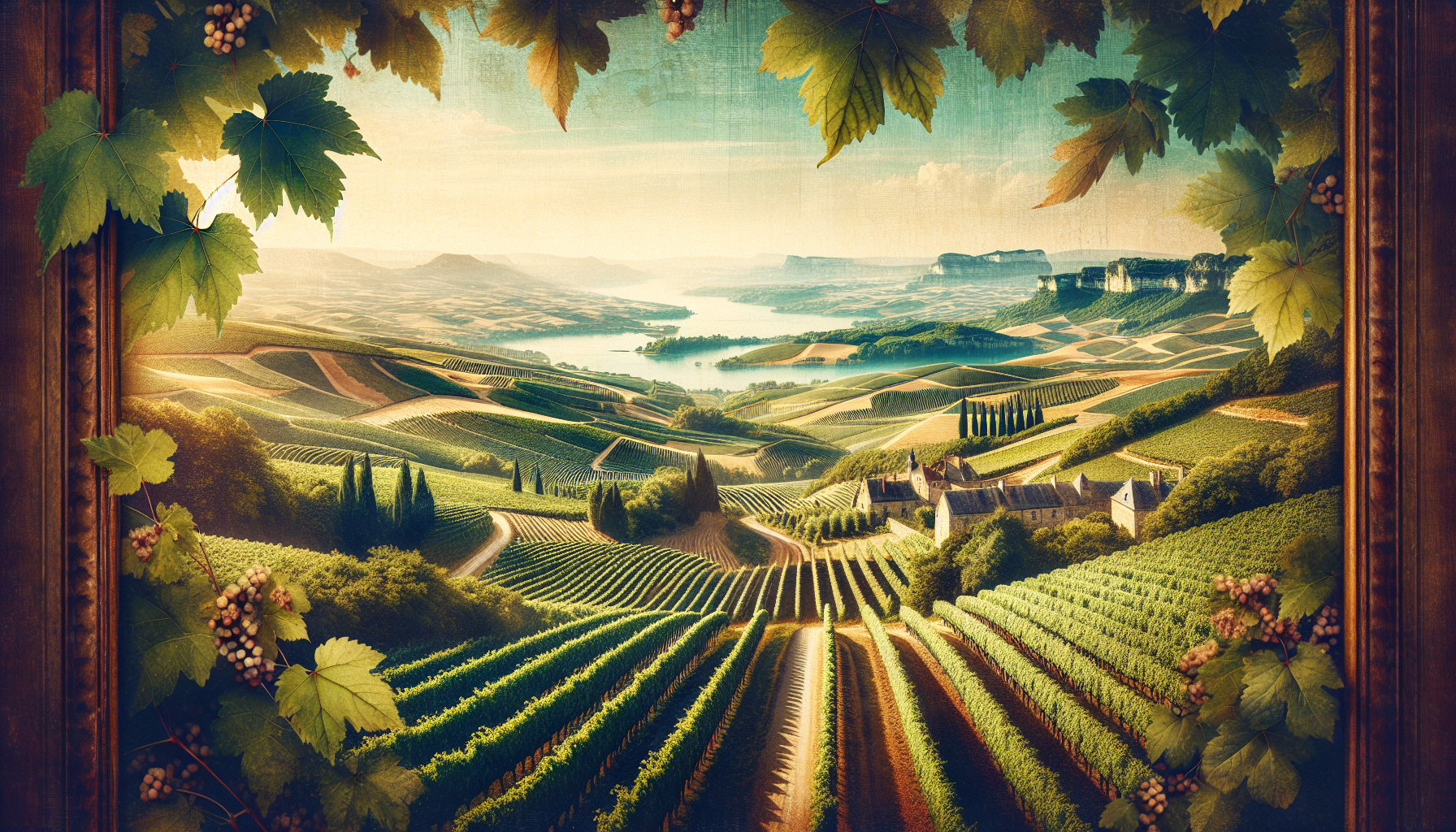France is renowned for its exceptional wines, each with its own distinct characteristics shaped by the diverse regions where they are produced. In this article, you will embark on a journey through the picturesque vineyards of France, uncovering the rich history and delightful flavors that are waiting to be discovered. From the prestigious vineyards of Bordeaux to the sun-drenched fields of Provence, prepare to be enchanted by the allure of French wine as you explore its various regions and learn about the fascinating winemaking tradition that has shaped this country’s culture for centuries. So, grab a glass, we’re about to embark on an unforgettable adventure through the wine regions of France.

Bordeaux
History and Background
Bordeaux, located in southwestern France, is one of the most prestigious wine regions in the world. With a rich history dating back to Roman times, Bordeaux has been producing exceptional wines for centuries. The region gained prominence in the 12th century when Eleanor of Aquitaine married King Henry II of England, resulting in significant trade between Bordeaux and England.
Climate and Terroir
Bordeaux’s climate is influenced by its proximity to the Atlantic Ocean and the Gironde Estuary. This maritime climate provides a moderate temperature and high humidity, ideal for grape cultivation. The region’s unique terroir, characterized by its gravelly soil, allows for excellent drainage and imparts minerality to the wines.
Grapes and Wine Styles
Bordeaux is known for its blended red wines, primarily made from Cabernet Sauvignon, Merlot, and Cabernet Franc grapes. The left bank of the Gironde River produces bold and tannic wines, dominated by Cabernet Sauvignon, while the right bank produces softer and more approachable wines, mainly composed of Merlot. Bordeaux is also renowned for its dry white wines, which are typically a blend of Sauvignon Blanc, Sémillon, and Muscadelle.
Châteaux of Bordeaux
The iconic châteaux of Bordeaux are a significant attraction for wine enthusiasts. These grand estates, with their beautiful architecture and sprawling vineyards, showcase the region’s rich viticultural heritage. Some notable châteaux include Château Margaux, Château Lafite Rothschild, and Château Haut-Brion. Many of these estates offer tours and tastings, providing visitors with the opportunity to experience the elegance and grandeur of Bordeaux wines firsthand.
Popular Wine Tours
Bordeaux offers a plethora of wine tours that cater to all levels of wine knowledge. From guided tours of famous châteaux to bicycle tours through vineyards, there is a tour for everyone. Visitors can also explore the city of Bordeaux itself, with its charming streets, delightful restaurants, and vibrant wine bars. The Cité du Vin, a world-class wine museum, is a must-visit for wine enthusiasts, offering interactive exhibits and tasting experiences.
Burgundy
History and Background
Burgundy, located in central France, is renowned for its exceptional Pinot Noir and Chardonnay wines. With a history dating back to the Roman era, Burgundy has long been esteemed for its winemaking traditions. The region gained global recognition during the Middle Ages when the powerful Dukes of Burgundy promoted the production of high-quality wines.
Climate and Terroir
Burgundy experiences a continental climate, with cold winters and warm summers. The region’s diverse terroir, which includes limestone, clay, and marl soils, gives the wines their distinct character. Burgundy’s vineyards are classified into designated plots called “climats,” which reflect the unique combination of soil, exposure, and microclimate.
Grapes and Wine Styles
Burgundy is primarily known for its red wines made from Pinot Noir grapes and its white wines made from Chardonnay grapes. The red wines of Burgundy, known for their elegance and complexity, showcase the terroir-driven characteristics of each vineyard. The white wines, typically unoaked, display a combination of floral, fruit, and mineral notes, reflecting the nuances of the region’s diverse terroir.
The Côte d’Or
The Côte d’Or, located in the heart of Burgundy, is home to some of the most prestigious vineyards in the world. Divided into the Côte de Nuits and the Côte de Beaune, this narrow strip of land produces some of Burgundy’s most sought-after wines. The Côte de Nuits is renowned for its red wines, including famous appellations such as Gevrey-Chambertin and Vosne-Romanée. The Côte de Beaune, on the other hand, is known for its exceptional white wines, including Puligny-Montrachet and Meursault.
Chablis and Beaujolais
Beyond the Côte d’Or, Burgundy is also home to other notable sub-regions. Chablis, located in the northernmost part of Burgundy, is renowned for its crisp and mineral-driven white wines made from Chardonnay grapes. Beaujolais, situated in the southern part of Burgundy, produces light and fruity red wines made from Gamay grapes, with the cru villages offering more complex and age-worthy expressions.
Champagne
History and Background
Champagne, synonymous with celebration and luxury, is the most famous sparkling wine in the world. The region’s winemaking history dates back over a thousand years when monks in medieval times first cultivated vineyards in this northeastern part of France. However, it was not until the 17th century that Champagne’s unique sparkling wine production method was developed, revolutionizing the wine industry.
Climate and Terroir
Champagne’s climate is classified as cool continental, characterized by cold winters and mild summers. The region’s unique terroir, with its chalky soils, plays a crucial role in the production of high-quality grapes. These chalky soils offer excellent drainage and provide the wines with their signature minerality and freshness.
Grapes and Wine Styles
Champagne is made primarily from three grape varieties: Chardonnay, Pinot Noir, and Pinot Meunier. Chardonnay contributes elegance and finesse, while Pinot Noir adds body and structure, and Pinot Meunier brings fruitiness to the blend. Champagne styles range from non-vintage, which reflects the characteristics of the house style, to vintage, which showcases the unique characteristics of a single year’s harvest. There are also rosé Champagnes, made by either blending red and white wines or through a maceration process.
Champagne Houses
Champagne is home to numerous prestigious Champagne houses, known as Maisons, each with its own distinct style and history. Houses like Moët & Chandon, Veuve Clicquot, and Dom Pérignon are renowned worldwide for their exceptional Champagne. Visitors can take tours of these houses, exploring their atmospheric cellars and learning about the intricate process of Champagne production. Tastings often include the opportunity to sample various styles, allowing visitors to appreciate the complexity and artistry of the wines.
Tasting and Tours
To fully immerse yourself in the Champagne region, it’s highly recommended to go on a wine tour. The Champagne route, known as the “Avenue de Champagne” in the town of Épernay, offers a scenic drive through vineyards, passing by numerous Champagne houses and picturesque villages. In addition to cellar tours and tastings, visitors have the opportunity to visit small, family-owned Champagne producers, often offering an intimate and authentic experience. From exploring the history of Champagne in Reims, with its stunning Gothic cathedral, to enjoying the stunning vineyard vistas, a visit to Champagne is truly a feast for all the senses.
Rhône Valley
History and Background
The Rhône Valley, located in southeastern France, is renowned for its bold and full-bodied wines. Winemaking in the region dates back over 2,000 years, with the Romans recognizing the potential of the Rhône’s fertile soils. In the Middle Ages, the Popes of Avignon played a significant role in promoting Rhône wines, elevating their reputation.
Climate and Terroir
The Rhône Valley experiences a diverse range of climates due to its size, running from the cold and continental climate in the north to a Mediterranean climate in the south. This variation in climate allows for the production of a wide range of grape varieties. The region’s terroir, characterized by its stony soils, provides excellent drainage and imparts a distinct mineral character to the wines.
Grapes and Wine Styles
The Rhône Valley is known for its red wines made from Syrah and Grenache grapes. In the northern Rhône, Syrah reigns supreme, producing powerful and age-worthy wines. These wines are often characterized by their dark fruit flavors, herbal notes, and peppery spice. In the southern Rhône, Grenache dominates the blends, creating rich and fruit-forward wines, often with the addition of other varieties such as Mourvèdre and Cinsault.
Northern Rhône
The northern Rhône is home to some of the most esteemed appellations in France. Côte-Rôtie, known for its elegant and complex Syrah-based wines, is a true expression of the region’s steep slopes and granite soils. Hermitage, with its diverse terroir, produces full-bodied, age-worthy wines. Other notable appellations include Cornas, Saint-Joseph, and Crozes-Hermitage, each offering their own unique characteristics.
Southern Rhône
In the southern Rhône, the region is dominated by the expansive appellation of Châteauneuf-du-Pape. This renowned appellation allows for up to 13 different grape varieties in its blends, resulting in rich and spicy wines with a distinct sense of place. Other notable appellations in the southern Rhône include Gigondas, Vacqueyras, and Côtes du Rhône, which offer excellent value and a wide range of wine styles.

Alsace
History and Background
Alsace, situated in northeastern France, has a unique history and cultural identity. Over the centuries, the region has been influenced by both French and German traditions, resulting in a distinct blend of cultures. This fusion is reflected in Alsace’s wines, where German grape varieties are cultivated alongside traditional French varieties.
Climate and Terroir
Alsace’s climate is classified as semi-continental, with hot summers and cold winters. The region is sheltered by the Vosges Mountains, creating a rain shadow effect and providing protection from the Atlantic’s maritime influence. This unique microclimate, coupled with the region’s diverse soils, including granite, limestone, and sandstone, allows for the cultivation of a wide range of grape varieties.
Grapes and Wine Styles
Alsace is best known for its aromatic white wines, which account for nearly 90% of the region’s production. Riesling, Gewürztraminer, and Pinot Gris are the noble grape varieties of Alsace, producing wines with intense aromas, rich flavors, and a crisp acidity. The region also produces excellent Pinot Blanc, Sylvaner, and Muscat wines. Alsace’s dry white wines showcase purity and finesse, while its Vendanges Tardives and SGN (Sélection de Grains Nobles) wines are renowned for their exceptional sweetness and complexity.
Alsace Wine Route
The Alsace Wine Route is a popular tourist attraction, stretching for approximately 170 kilometers from Marlenheim in the north to Thann in the south. The route winds through picturesque villages and vineyard landscapes, offering visitors the opportunity to discover charming wineries and taste a wide variety of Alsace wines. The route also provides insights into the region’s rich architectural heritage, with half-timbered houses and flower-filled streets creating a truly idyllic atmosphere.
Architecture and Culture
In addition to its wines, Alsace is known for its stunning architecture and vibrant cultural scene. The region’s charming villages, such as Colmar and Eguisheim, are renowned for their well-preserved medieval buildings and colorful facades. Visitors can explore castles, such as Haut-Koenigsbourg, and experience the region’s history firsthand. Alsace also hosts numerous festivals throughout the year, celebrating its diverse traditions, including the famous Christmas markets, which attract visitors from all over the world.
Provence
History and Background
Provence, located in the southeast of France, is not only known for its breathtaking landscapes and idyllic coastline but also its excellent rosé wines. This region has a long and storied history of winemaking, with evidence of vine cultivation dating back to 600 BC. Provence’s winemaking traditions were further shaped by the Greeks, Romans, and later the Knights Templar.
Climate and Terroir
Provence experiences a Mediterranean climate with hot, dry summers and mild winters. The mistral, a strong wind that blows through the region, creates a cooling effect on the vineyards, helping to maintain the grapes’ acidity. The diverse terroir of Provence, with its limestone, schist, and clay soils, contributes to the complexity and character of the wines.
Grapes and Wine Styles
Provence is best known for its rosé wines, which account for nearly 90% of the region’s production. These wines are typically made from a blend of red grape varieties, including Grenache, Syrah, Cinsault, and Mourvèdre. Rosé wines from Provence are distinguished by their pale pink color, delicate floral aromas, and refreshing acidity. The region also produces red and white wines, with the reds often displaying fruity flavors and the whites showcasing vibrant citrus and stone fruit notes.
Côtes de Provence
Côtes de Provence is the largest appellation in Provence, covering a vast area from the hills of Sainte-Victoire to the Mediterranean coast. This renowned appellation produces a wide range of wines, from crisp and aromatic whites to full-bodied and elegant reds. However, it is the rosé wines of Côtes de Provence that have gained international acclaim, known for their pale hue, delicate fruit flavors, and balanced acidity.
Rosé Wine Production
Provence’s expertise in rosé winemaking is unparalleled. The region’s winemakers carefully control the maceration process to extract just the right amount of color from the grape skins, resulting in the beautiful pale pink hues. The wines are then aged in stainless steel tanks or oak barrels to preserve their freshness and fruitiness. Provence has become synonymous with summer, and enjoying a chilled glass of rosé on a sunny terrace is the perfect way to experience the region’s joie de vivre.
Loire Valley
History and Background
The Loire Valley, often referred to as the “Garden of France,” is located in the central part of the country. This picturesque region is home to some of France’s most diverse and vibrant wines. The Loire Valley has a long winemaking history, dating back to the Roman era, and its wines have been treasured by kings and nobles throughout the centuries.
Climate and Terroir
The Loire Valley benefits from a cool continental climate, with maritime influences from the Atlantic Ocean. The region’s terroir varies significantly along the length of the Loire River, with different soil types and microclimates. The vineyards are planted on limestone, clay, flint, and slate soils, each contributing to the unique characteristics of the wines.
Grapes and Wine Styles
The Loire Valley is known for its diverse range of grape varieties and wine styles. The region produces exceptional white wines made from Sauvignon Blanc, Chenin Blanc, and Melon de Bourgogne grapes. The Sauvignon Blanc wines of Sancerre and Pouilly-Fumé are renowned for their vibrant acidity and pronounced citrus and mineral notes. Chenin Blanc, with its versatility, produces dry, off-dry, and sweet wines, including the renowned Vouvray and the luscious Coteaux du Layon. Melon de Bourgogne is the grape variety used to make the crisp and refreshing Muscadet wines.
Nantes and Muscadet
Nantes, located on the western end of the Loire Valley, is known for its Muscadet wines. Muscadet is made from the Melon de Bourgogne grape and is characterized by its vibrant acidity, subtle fruit flavors, and unmistakable “sur lie” aging. The proximity to the Atlantic Ocean gives Muscadet wines a unique saline character, making them a perfect accompaniment to fresh seafood.
Touraine and Chenin Blanc
In the central part of the Loire Valley, the region of Touraine produces a wide variety of wines. Wines made from Chenin Blanc grapes are a highlight of the region. Vouvray, made from Chenin Blanc, offers a range of styles from dry to sweet, with vibrant acidity and notes of honey, white flowers, and tropical fruits. Touraine also produces red wines, notably from the Gamay, Cabernet Franc, and Malbec grapes.
Languedoc-Roussillon
History and Background
The Languedoc-Roussillon region is located in the southern part of France and has a rich winemaking history that dates back over 2,000 years. Historically known for its vast quantities of bulk wine, the region underwent a significant transformation in the late 20th century, focusing on quality rather than quantity. As a result, Languedoc-Roussillon has become synonymous with excellent value and individualistic wines.
Climate and Terroir
Languedoc-Roussillon enjoys a Mediterranean climate, with hot, dry summers and mild winters. The region’s proximity to the Mediterranean Sea provides a cooling influence, allowing for the cultivation of a wide variety of grape varieties. The diverse terroir of Languedoc-Roussillon, with its limestone, schist, and clay soils, adds complexity and character to the wines.
Grapes and Wine Styles
Languedoc-Roussillon is a vast and diverse region that produces a wide range of grape varieties and wine styles. The region is known for its bold and full-bodied red wines made from Grenache, Syrah, Mourvèdre, and Carignan grapes. These wines often exhibit dark fruit flavors, spice, and earthy notes. Languedoc-Roussillon also produces refreshing white wines from varieties such as Viognier, Marsanne, and Roussanne, as well as traditional-method sparkling wines.
Garrigue and Mediterranean Influence
The unique landscape of Languedoc-Roussillon is characterized by rugged mountains, vine-covered hillsides, and the aromatic scrubland known as garrigue. The garrigue, with its fragrant herbs such as thyme, lavender, and rosemary, imparts distinctive aromas to the wines. The Mediterranean influence is also evident in the region’s cuisine, with fresh seafood, olives, and garlic playing starring roles in the local dishes.
Cathar Castles and Wine Routes
In addition to its wines, Languedoc-Roussillon is home to a wealth of cultural and historical attractions. The region is dotted with ancient Cathar castles, perched on rocky outcrops and steep hillsides. These castles tell the story of the Cathar heresy and provide breathtaking panoramic views of the surrounding vineyards. Wine enthusiasts can also explore the numerous wine routes, such as the Minervois and Corbières wine routes, which offer the chance to visit charming wineries and taste the region’s diverse wines.
Corsica
History and Background
Corsica, known as the “Isle of Beauty,” is an island located in the Mediterranean Sea, just south of the French mainland. The island has a fascinating history and a unique cultural identity, with influences from both France and Italy. Corsica’s winemaking traditions have been shaped by the diverse cultures that have inhabited the island over the centuries.
Climate and Terroir
Corsica experiences a Mediterranean climate, with hot, dry summers and mild winters. The island’s diverse topography, which includes mountains, valleys, and coastal plains, creates a range of microclimates that influence the grapes’ ripening process. The island’s soils, composed of granite, schist, and limestone, contribute to the wines’ complexity and character.
Grapes and Wine Styles
Corsica produces a variety of grape varieties, both indigenous and international, resulting in diverse wine styles. Nielluccio, a variant of Sangiovese, is the most widely planted red grape variety and produces medium-bodied wines with notes of red fruit and herbs. Sciaccarello, another red grape variety, yields light and aromatic wines with a distinctively Corsican character. Vermentino, known locally as Rolle, is the prominent white grape variety, producing crisp and citrus-driven wines.
Unique Corsican Varieties
Corsica is also home to several unique and rare grape varieties that are found almost exclusively on the island. Biancu Gentile, for example, is a white grape variety that almost disappeared but has experienced a revival in recent years. It produces aromatic and elegant wines with floral notes and bright acidity. Similarly, Carcajolo Nero, a red grape variety, offers wines with lively fruit flavors and a spicy character.
Coastal Beauty and Wine Tours
Corsica’s stunning coastline, with its crystal-clear waters and picturesque beaches, is a major attraction for visitors. The island’s vineyards often overlook the sea, providing a beautiful backdrop for wine tasting and tours. Wine enthusiasts can explore the diverse wine regions of Corsica, such as Patrimonio in the north and Ajaccio in the west, visiting tasting rooms and enjoying the scenic beauty of the vineyards. Additionally, Corsica boasts a vibrant culinary scene, where wine and food are celebrated together, allowing visitors to indulge in the island’s rich gastronomic traditions.
Southwest France
History and Background
Southwest France, known as “Sud-Ouest” in French, is a diverse and lesser-known wine region that stretches from Bordeaux to the Pyrenees mountains. The region’s winemaking history dates back to Roman times when the Gauls began cultivating vines. Over the centuries, Southwest France has experienced various influences, from the Celts and Romans to the English and Spanish, shaping its unique cultural heritage.
Climate and Terroir
Southwest France encompasses several distinct sub-regions, each with its own climate and terroir. The region as a whole benefits from a maritime climate, with the influence of the Atlantic Ocean moderating temperatures. The varied terroir includes limestone, clay, and gravel soils, creating a diverse range of wines with different characteristics.
Grapes and Wine Styles
Southwest France is known for its diverse array of grape varieties and unique wine styles. The region produces both red and white wines, as well as sweet and fortified wines. Some notable grape varieties include Malbec, Tannat, Merlot, and Cabernet Sauvignon for red wines, and Colombard, Gros Manseng, and Sauvignon Blanc for white wines. The region’s sweet wines, such as those made from the late-harvested grapes in Jurançon, are world-renowned for their complexity and elegance.
Cahors and Malbec
Cahors, located in the Lot Valley, is known as the birthplace of Malbec. The region’s vineyards are planted on the limestone plateau, providing excellent drainage and imparting minerality to the wines. Cahors produces robust and full-bodied red wines made primarily from Malbec, known locally as “Côt.” These wines are characterized by their dark fruit flavors, firm tannins, and age-worthiness.
Jurançon and Sweet Wines
Jurançon, located in the foothills of the Pyrenees, is renowned for its sweet wines. The vineyards of Jurançon benefit from the warm and sunny climate, as well as the cooling influence of the mountains. The region specializes in late-harvested wines made from Petit Manseng grapes, which develop high sugar levels and excellent acidity. Jurançon’s sweet wines are luscious and aromatic, with flavors of honey, apricot, and exotic fruits.
In conclusion, the wine regions of France offer a diverse and captivating experience for wine lovers. From the prestigious estates of Bordeaux to the picturesque vineyards of Alsace, each region has its own unique history, climate, terroir, and grape varieties, resulting in a wide array of wines styles and flavors. Whether you prefer the elegance of Burgundy, the celebration of Champagne, or the rustic charms of the Southwest, there is a wine region in France waiting to be explored. So raise a glass and embark on a journey through the terroirs and traditions of France’s remarkable wine regions. Cheers!

